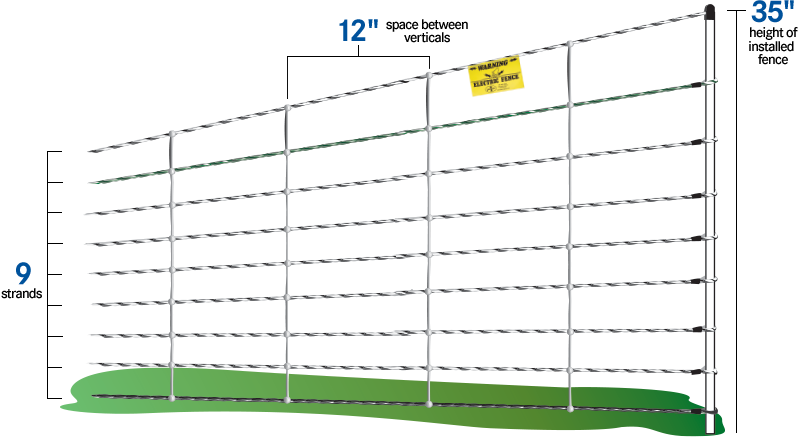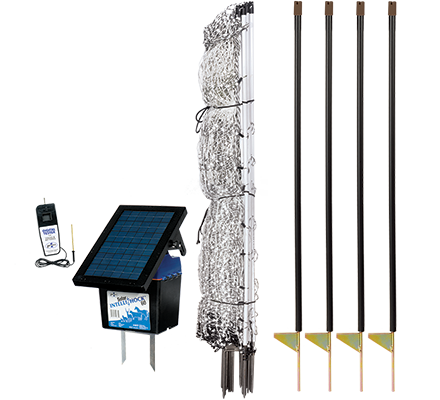How Electric Fence & Netting Works
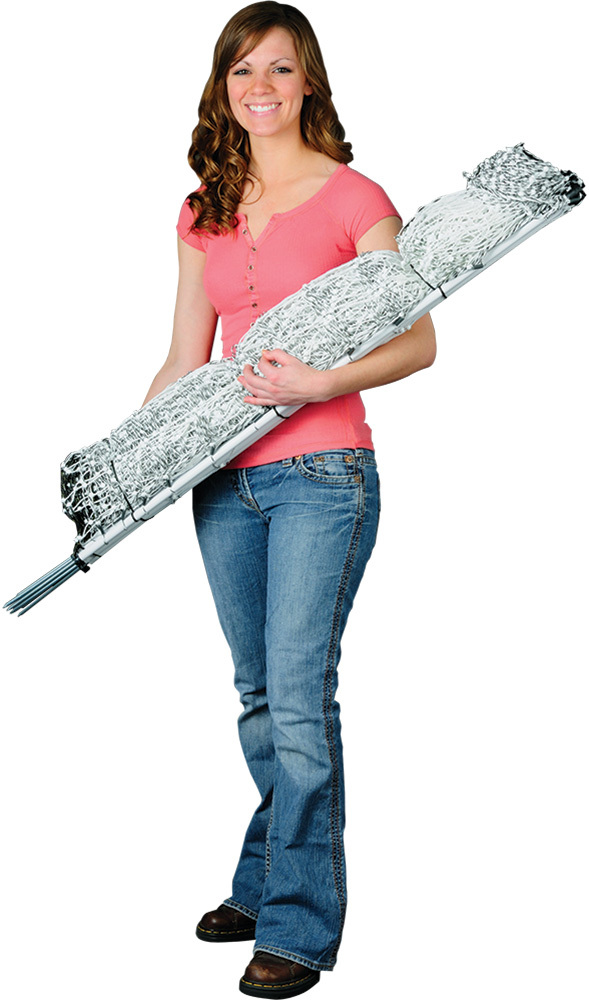
What is electric netting?
It’s an electrifiable, prefabricated, portable fence that arrives to your door as a complete roll with the line posts already built in. The fence’s “mesh” is composed of plastic verticals “welded” to electrifiable polywire. The net is supported by PVC (or fiberglass composite) posts which are spaced throughout the netting. Each line post has a steel spike at the base that’s inserted into the ground for support. A standard roll (164 ft) inclusive of posts weighs between 15–25 lbs.
Electric netting is NOT physically strong. Rather, it relies upon pain and the animal’s memory. When properly energized, animals touch it, quickly learn the fence is painful—and then avoid it.
- Temporary electric netting is your best choice for fast-paced rotational grazing set-ups, or for situations where you need to frequently move the fence.
- Semi-permanent netting (e.g. PermaNets and QuikFences) can be used when you need the fence installed for weeks or months at a time. But they aren’t as easy to handle and will require more maintenance than permanent fences.
Consider a electric netting kit if you’re new to using an electric fence. Why? Because all the parts and pieces necessary are included.
How electric netting works…
The visual combination of a close mesh of vertical and horizontal wires encourages animals to touch it with their sensitive nose, ears or beak. The horizontal strands are conductive. (An exception is the bottom strand that rests on the ground.) When the fence is energized, a very brief, high-voltage pulse travels through the wires. When an animal touches the fence, they receive a painful shock—and learn to avoid it.
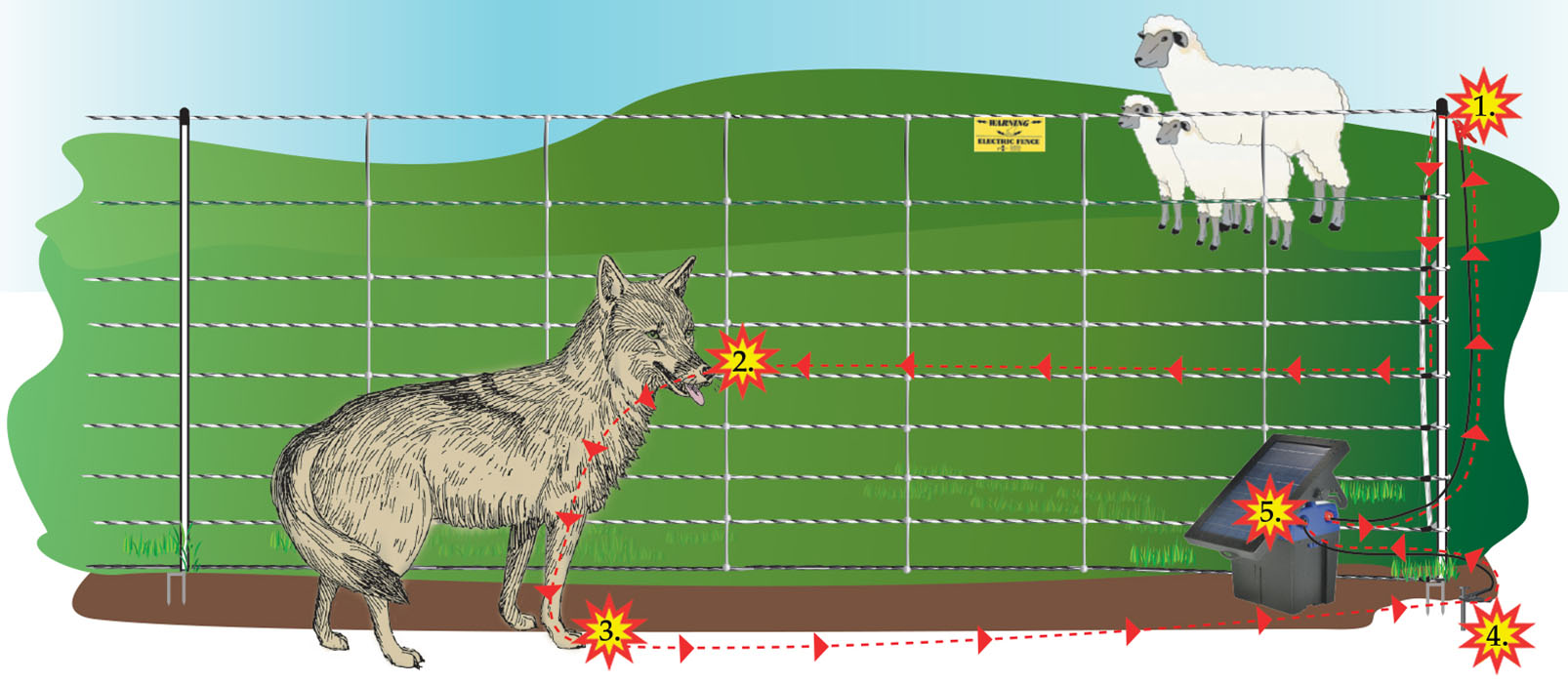
Factors that affect a pulse’s strength and shock effect…
- Joules of output from the energizer equal the volume of electrons in a pulse. The more joules, the larger the potential shock effect to an animal.
- Resistance of conductors, animal and soil. High total resistance absorbs more electrons and reduces the shock effect.
- Electron loss via grass contact and poor insulators. Electrons that leak this way are not available to shock the animal.
- Changing weather and seasonal conditions. Dew, fog, rain and general humidity will negatively affect voltage. The electric pulse will more readily jump (arc) from the hot wires to wet vegetation, which is more likely in the morning when the dew is still on.
- Soil resistance. When the soil is dry, sandy or rocky, fewer electrons are able to be received by the ground rod, thus pulse strength is diminished.
- Without proper grounding, the fence’s electrical circuit can not be completed. As a result, it will not be an effective pain barrier to animals.
The more power your energizer can put through the conductive wires, the more “problems” you can have with the fence and still maintain voltage on the entire length of the fence line. A good rule of thumb is to buy a larger fence energizer than you’ll think you need. When the fence pleases, most folks will buy more fence—and need additional output.
Electric Netting FAQs
Net Numbering System
installed
Q: Will electric netting stop predators?
Ground-based predators such as coyotes, foxes, fisher cats, skunks, raccoons, opossum, weasels, dogs and even bears are deterred by electric fence. Aerial predators (e.g. hawks, eagles, owls) are the exception. When containing poultry, set up narrow runs to reduce flying predators’ swooping ability, or drape Aerial Protection Net over the enclosure.
Note: Lightweight garden varmints, such as squirrels and chipmunks do NOT make good foot-to-soil contact. As such, these critters won’t receive a memorable shock. Squirrels are especially cunning; they often jump onto the fence without making any ground contact. Without ground contact, an animal won’t be shocked. (This is why birds can perch on power lines without being electrocuted.)
Q: Do different animals require different fences?
Yes/no. Fencing for the hardest to contain animal will work for the easiest to contain.

- Example 1: Chickens and goats—fence for the chickens
- Example 2: Goats, pigs and cows—fence for the goats
Temporary fences that are not physically strong pose the greatest risk of escape (or entanglement) to newly acquired animals. It pays to train them first!
Set up a temporary fence alongside (1 to 2 ft away) a secure permanent fence that the animals can’t get through. Make sure the temporary fence is electrified—at least 3000V at the end of fence. Introduce the animals to the fence and monitor for a few hours. That way if one were to get into the fence and get caught, you can turn the power off and get them loose.
To reduce the risk of animals challenging netting:
- Do NOT allow animals of the same species (i.e. sheep/sheep) to be on both sides of a net at the same time.
- Never use netting to separate mothers from weaned progeny.
- Never force animals against netting; give them time and space to avoid contacting it.
- Keep netting energized! A common mistake is not electrifying it. Electric fence is a pain barrier, not a physical barrier. Use a high-output fence energizer to combat weed contact and intimidate animals.
Q: What is the effect of dry soil?
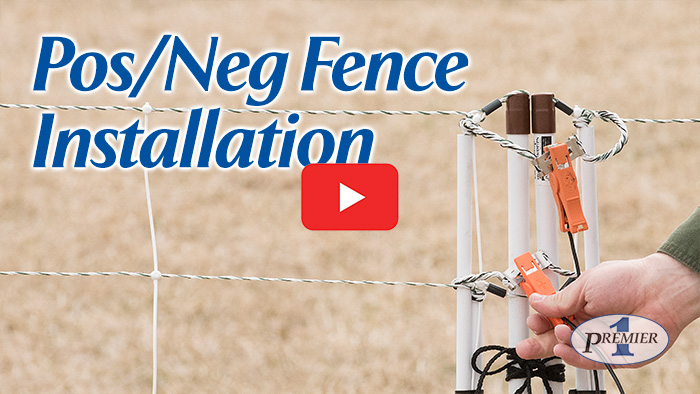
Moisture determines the conductivity (or not) of soil. Dry soil increases resistance and absorbs more electrons. A weaker, less effective pulse occurs that does not deter animals.
To overcome this, use positive/negative fences (Pos/Neg), wide impedance energizers, higher output units and/or more ground rods.
In order to receive a shock from a Pos/Neg fence, the animal must touch both a positive (hot) and negative (grounded) strand at the same time. This will deliver more pain to the animal than an all hot net (Pos/Pos) because moisture in the soil is not required to complete the circuit.
Q: I have more length than I need. What should I do with the excess?
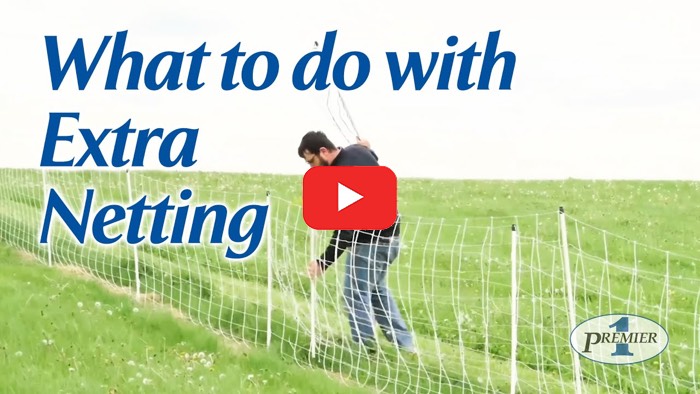
An electric fence does NOT have to make a circle and the clips at the end of the net are not required to connect.
We recommend two methods for dealing with excess netting:
- Overlap the fences. As long as none of the electrified strands are sagging and touching the ground, the fences may be set side by side.
- Make a U-turn. This method involves a FiberTuff (or other insulated post) and results in a convenient gate:
- Insert one FiberTuff next to your starting post and construct your enclosure.
- When you return to your starting point, make a 180° turn around the FiberTuff, overlapping the excess net alongside the original. It’s okay if the conductors touch one another. (Pos/Neg netting is an exception. See below.) Try to keep all conductors from touching the ground—this will reduce the effectiveness of the shock effect.
- Secure the FiberTuff to the original starting post with the storage string to enter/exit the paddock.
Pos/Neg fences may be run alongside one another, but make sure to keep the fences at least 3–6" apart. If the metal conductors come in contact with one another, it will create a short.
Why Premier “knows” netting…
Electric netting has been in use at Premier for over 50 years (since 1970)—longer than anyone in the US. We use miles of it on our farms year-round, in all weather. And, we talk daily to netting users nationwide — who let us know what they like and/or dislike.
How many rolls do I need?
Because netting is so portable, you can choose not to fence the entire pasture.
Instead, subdivide the pasture into manageable paddocks with your choice of dimensions, moving the fence as needed.
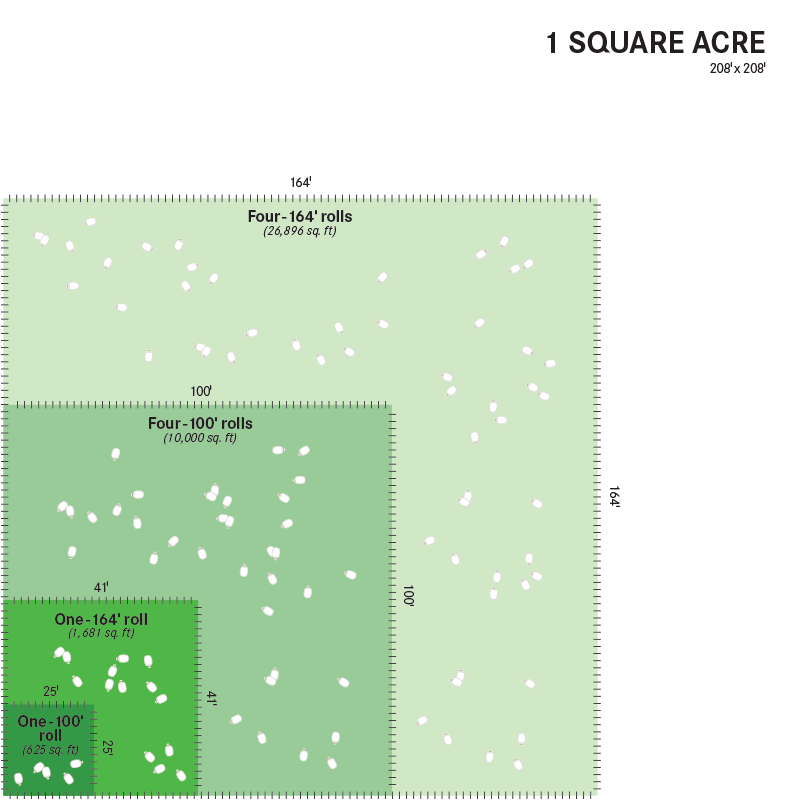
(approx. 2/3rd acre)
(approx. 1/4th acre)
Why users like netting so much…
It’s almost a mistake to call netting a fence. Why? Because the word “fence” suggests a barrier that’s costly, time-consuming and complicated to install and won’t be removed for decades. But netting is the exact opposite:
- ✔ Complete
- Netting is a complete fence on its own—lacking only a suitable fence energizer. Line posts are built in to each roll. FiberTuff™ posts can be used for extra support at corners and ends.
- ✔ Simple (and quick!) to install
- Netting doesn’t require a contractor to install. Very little “sweat energy” is needed and no tools! 600 ft can be moved or installed in an evening by nearly anyone over 12 years old.
- ✔ Dependable
- New users are often surprised that livestock and wildlife very quickly learn to fear the fence. When adequately electrified, netting is very effective. A roll of netting will last 8–10 years if used with care. Lawn mowers and ice storms are its worst enemies!
- ✔ Adaptable
- Netting is so easy to move that it’s often moved several times a season. Use it to fence around obstacles or dips and curves in difficult terrain.
- ✔ Ships FREE to your door!
What users dislike...
- The fence line must be mowed when green grass covers the lowest “live” strand. The alternative is to apply a strip of herbicide to kill weeds.
- Ice and heavy snow can flatten and thereby damage it. That’s why most choose to store netting fences for the winter.
- High wind can lean it over.
- Electric netting will sag without support posts at corners and ends. “Plus” nets include additional line posts to reduce sag (in exchange for added weight.) For most, sagging net is a cosmetic problem, not a functional one. At worst, excessive sagging may reduce the “shock” effect when lower electrified stands make contact with the ground. SagStopper™ for 48" tall nets can solve both problems. Less sagging = more eye appeal and less ground contact.
- Animals may become entangled in it—and die. On a % basis, entanglement is very rare, but it can and does occur.
Not sure what you need?
Try our fencing kits and energizer kits
Why? Because all the parts and pieces necessary are included. You don’t have to worry about overlooking the key extra items that folks new to electric fence normally need to make an electric fence operational.
If your plans involve longer fences, bypass the kit option and instead buy the individual parts and pieces—because the items needed are likely to vary considerably.
To Reduce Risk and Liability...
Are electric fences a serious safety risk to humans?
Because touching an electric fence is painful and the voltages are high, most assume that the risks from an energized fence must also be high. That’s a myth. Consider that millions of people throughout the world are “exposed” to millions of electric fences every day—yet they are involved in (but are not always the cause of) less than one human death or serious injury per year worldwide. Compare that to the number of annual injuries and deaths that occur from human exposure to tractors, skid loaders, ladders, PTO shafts, balers, mowers, combines, bulls, stallions, rifles, shotguns, knives, etc. This is not to suggest that there is no risk at all. There is, indeed, a small level of risk. And with risk, there is also liability to the fence’s owner.
For safer electric fences:
- Make them visible to humans and animals. Visibility is increased by contrast. (That’s why many Premier nets are black and white in color.)
- Educate. Hang warning signs on all electric fences. Tell children to never touch it. Everyone should avoid head and neck contact.
- Allow space for people and animals to walk easily along or around it.
- Avoid high-output fence energizers (greater than 8 joules) unless they include delayed pulse technology. It’s best not to use high-output energizers on short fences that have public exposure.
What NOT to do!
- Never place your head or upper spine near an electrified wire. Accidental head or neck contact can occur when pushing a voltage probe into the soil. Be careful when doing so to avoid head-to-wire contact!
- Never attempt to step over or climb through an energized fence of any kind.
- Never encourage anyone to touch an electric fence.
- Do NOT use an energizer that is labeled high impedance, continuous current, weed burner or weed chopper. We recommend only low or wide impedance pulse energizers.
Warning!
In 1991 an accidental fatality occurred when a young child’s head contacted an electrified fence while the child was crawling on wet grass. The fence was correctly installed and functioning properly. The energizer was a UL approved unit. As a result, Premier strongly advises against allowing toddlers access to any electrified fences. Also, due to this incident and others, experts now suggest that human contact by an energized wire to the head and neck may be the most dangerous point of contact. We urge all to especially avoid this kind of contact.


